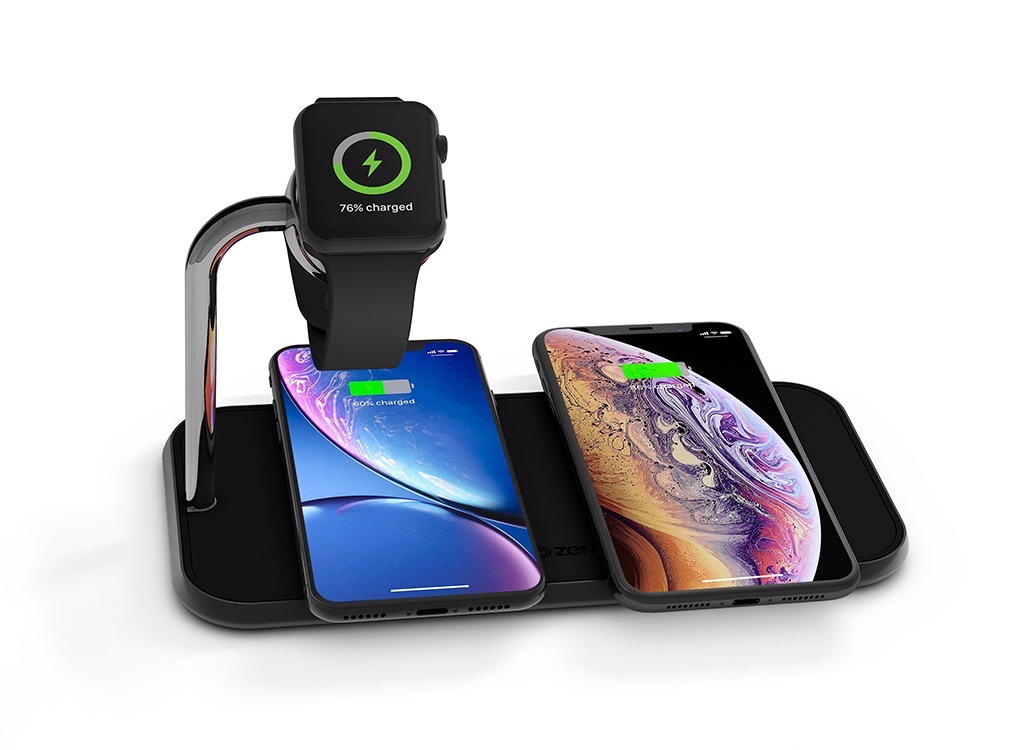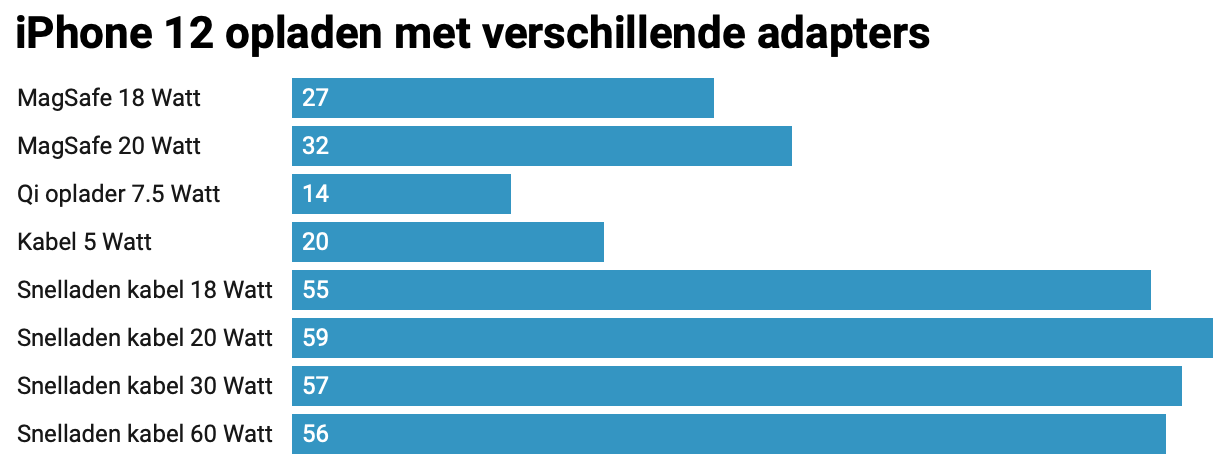There was quite a bit of anger when it turned out that the 18 Watt charger not suitable is for fast charging of the iPhone 12. In the responses under that article, you can read that many readers feel cheated. We therefore started testing to see if it really makes a lot of difference. And guess what? That 20 Watt adapter is not necessary at all! Fast charging at 18 Watt also works fine.
Charging iPhone 12 with cables and wireless
Below you can see our test results. We have two identically furnished copies of the iPhone 12 in iPhone 12 Pro used, both of which have a battery capacity of 2815 mAh. Each time we let the battery drain to 0% and then we put the iPhone on the charger for exactly 30 minutes.
| Charging method | Wattage | Percentage after 30 minutes of charging |
|---|---|---|
| MagSafe | 18 Watt | 27% |
| MagSafe | 20 Watt | 32% |
| Qi charger | 7,5 Watt | 14% |
| Charging with cable | 5 Watt | 20% |
| Charging with cable | 10 Watt | 38% |
| Fast charging with cable | 18 Watt | 55% |
| Fast charging with cable | 20 Watt | 59% |
| Fast charging with cable | 30 Watt | 57% |
| Fast charging with cable | 60 Watt | 56% |
| USB-C-poort in MacBook* | Unknown, approx. 10-12 Watt? | 42% |
* 13-inch top USB-C port MacBook Air 2020
Apple says that you need at least a 20 Watt adapter for fast charging of the iPhone 12 from 25 euros Need. But that’s nonsense. The 18 Watt charger would not be suitable, but our measurements show that it does not make much difference at all. If you use an 18 Watt USB-C adapter, you get about the same results than with a heavier adapter. It all ends up in the neighborhood of 55% -59%.
OK, the measurement with the 20 Watt adapter gets the highest score, but the difference is not so great that you have to throw your 18 Watt adapter in the trash. We do not recommend the latter anyway, because you can still charge perfectly with any type of adapter. It’s just not always at top speed.
Below you can see the results in a graph:
Wireless charging with MagSafe is half as fast
What our measurements also show nicely is that charging with MagSafe is half as fast. While you end up around 60% with a cable, MagSafe will get you around 30%. With that measurement it is also clear that the 20 Watt charger performs better than the 18 Watt charger. But there is not much difference.
Apple says published last night supportdocument that charging with a less powerful adapter than 20 Watt will result in longer charging times. They don’t lie with that. But we would rather have read the whole story: that it doesn’t make that much difference that you have to have that 20 Watt adapter now.
The fact that the 30 Watt and 60 Watt adapters do not show noticeably better results is due to the fact that Apple has maximized the power for fast charging to around 20 Watts. A heavier adapter is not harmful (because it has protections built in), but it is also not faster.
Why is wireless slower than wired?
A question we regularly get is why wireless charging so much slower. You use a 20 Watt charger in both cases, but the result differs by a factor of two. This has to do with a number of things. Firstly, less losses occur with a cable, so that almost the full 20 watts can be used when charging and charging is faster. Another point is that although you can use a 20 Watt adapter, MagSafe can charge a maximum of 15 Watt. So you do not get the full 20 Watt from the adapter.
A magnetic charger such as the MagSafe Charger does have the advantage that the iPhone is always exactly right on the coils, so that charging can take place more efficiently.


We used this wireless charger to test Qi. Photo: Zens.
Qi half as fast as MagSafe
What is also clearly visible from our measurements is that Qi goes half as fast as MagSafe.
For charging with a Qicharger, we used the Zens Dual + Watch Fast Wireless Charger. It charges your iPhone with a power of 7.5 Watts.
When we took the iPhone off the charger after half an hour, we doubted whether the iPhone had been good on it. Only 14%? That is a very bad result. But it can be explained if you consider that Qi charging is included in the iPhone is maximized at 7.5 Watt. We reached less than half of the measurement we did with MagSafe.
What you also see in the table is that it is better to connect your slow 5 Watt adapter than one Qi-barns.
Heat development with MagSafe drawers
In the aforementioned supportdocument warns Apple that the iPhone and MagSafe Charger can get warm while charging. We did notice something of this during testing – but this also occurs with Qi charging.
It has to do with heat generation and the fact that wireless charging less efficient. Apple has come up with something for that. The software will ensure that the battery Do not charge above 80 percent to avoid damage to the accu to prevent. Charging will resume when the temperature has dropped again. You can also do something about this yourself: put your iPhone and charger in a cooler location, for example in a somewhat darker place in the house instead of in a sunny conservatory.
Further plans to test
We wanted to share these results with you, because we are a bit outraged that Apple is trying to convince you without further explanation that you really need a 20 Watt adapter. But we are not quite done yet. We now have the main charging methods for the iPhone 12 tested, but we are also curious whether charging via MagSafe with or without a cover makes a difference. We also want to know whether there is a difference between different Qi chargers and power banks.
Do you have any suggestions what we could test? Then let them know in the comments! Obviously we don’t have all chargers and adapters from exotic brands, but we’re coming to an end ????
Finally, an interesting fact: if you are charging your iPhone wirelessly and you also connect a Lightning cable, Lightning will take precedence.
–




